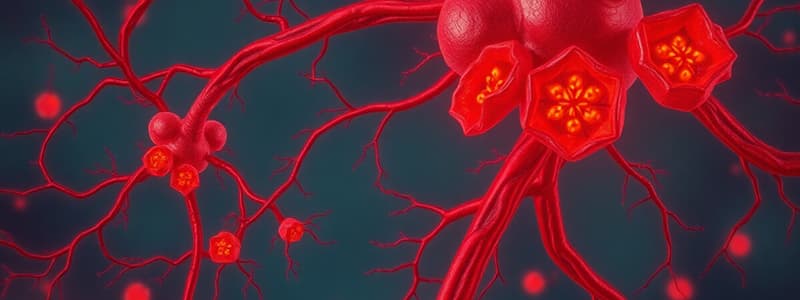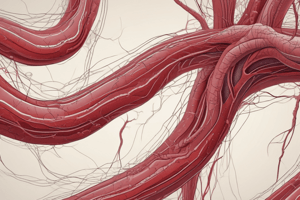Podcast
Questions and Answers
What are the three most common sites for venipuncture?
What are the three most common sites for venipuncture?
- Superficial veins of the dorsum of the foot (correct)
- Superficial veins of the ankle
- Superficial veins of the dorsum of the hand (correct)
- Superficial veins of the antecubital fossa (correct)
- Superficial veins of the neck
What is the most common skin antiseptic used for venipuncture?
What is the most common skin antiseptic used for venipuncture?
- 10% povidone-iodine
- 70% isopropyl alcohol (correct)
- 1% iodine tincture
- 2% chlorhexidine gluconate
What is the recommended depth of skin puncture for infants (< 1 year old)?
What is the recommended depth of skin puncture for infants (< 1 year old)?
- < 2.0 mm (correct)
- 2.0 mm - 2.5 mm
What is the recommended depth of skin puncture for adults?
What is the recommended depth of skin puncture for adults?
What is the most common type of anticoagulant used for routine hematology determinations?
What is the most common type of anticoagulant used for routine hematology determinations?
What is the preferred anticoagulant used for counting platelets?
What is the preferred anticoagulant used for counting platelets?
How many times should a blood collection tube be inverted for adequate mixing?
How many times should a blood collection tube be inverted for adequate mixing?
What is the first tube collected in the order of draw for skin puncture?
What is the first tube collected in the order of draw for skin puncture?
Warming the skin puncture site for no longer than 3 to 5 minutes can increase blood flow sevenfold.
Warming the skin puncture site for no longer than 3 to 5 minutes can increase blood flow sevenfold.
Prolonged tourniquet application can cause hemolysis in the blood sample.
Prolonged tourniquet application can cause hemolysis in the blood sample.
The first drop of blood from a skin puncture should be discarded.
The first drop of blood from a skin puncture should be discarded.
What is the minimum amount of information that should be on a blood collection tube?**
What is the minimum amount of information that should be on a blood collection tube?**
A phlebotomist should NEVER puncture a patient more than twice.
A phlebotomist should NEVER puncture a patient more than twice.
Choose the venipuncture site that should be avoided.
Choose the venipuncture site that should be avoided.
Choose all the factors that can affect the results of hematological tests when a prolonged tourniquet is used.
Choose all the factors that can affect the results of hematological tests when a prolonged tourniquet is used.
The EDTA anticoagulant concentration should be between 1.5 and 2.0 mg per mL of blood.
The EDTA anticoagulant concentration should be between 1.5 and 2.0 mg per mL of blood.
It is recommended to perform a CBC (Complete Blood Count) on EDTA blood specimens that are between 2 - 4 hours old.
It is recommended to perform a CBC (Complete Blood Count) on EDTA blood specimens that are between 2 - 4 hours old.
Which of the following is NOT a true statement about heparin?
Which of the following is NOT a true statement about heparin?
A gold top blood collection tube contains thixotropic gel.
A gold top blood collection tube contains thixotropic gel.
Sodium Fluoride is an anticoagulant.
Sodium Fluoride is an anticoagulant.
Which of the following is NOT a type of anticoagulant?
Which of the following is NOT a type of anticoagulant?
Flashcards
Plasma
Plasma
Liquid portion of unclotted blood specimen.
Serum
Serum
Liquid portion of clotted blood specimen.
RBCs
RBCs
Red blood cells, also known as erythrocytes or erythroplastids.
WBCs
WBCs
Signup and view all the flashcards
Platelets
Platelets
Signup and view all the flashcards
Arteries
Arteries
Signup and view all the flashcards
Veins
Veins
Signup and view all the flashcards
Capillaries
Capillaries
Signup and view all the flashcards
Hematology
Hematology
Signup and view all the flashcards
Anemia
Anemia
Signup and view all the flashcards
Hemolysis
Hemolysis
Signup and view all the flashcards
Elevated Erythrocyte Sedimentation Rate(ESR)
Elevated Erythrocyte Sedimentation Rate(ESR)
Signup and view all the flashcards
Hemostasis
Hemostasis
Signup and view all the flashcards
Erythropoiesis
Erythropoiesis
Signup and view all the flashcards
Vitamin B12 deficiency
Vitamin B12 deficiency
Signup and view all the flashcards
Folate deficiency
Folate deficiency
Signup and view all the flashcards
Megaloblastic anemia
Megaloblastic anemia
Signup and view all the flashcards
Aplastic anemia
Aplastic anemia
Signup and view all the flashcards
Iron deficiency anemia
Iron deficiency anemia
Signup and view all the flashcards
Microcytic anemia
Microcytic anemia
Signup and view all the flashcards
Intravascular hemolysis
Intravascular hemolysis
Signup and view all the flashcards
Extravascular hemolysis
Extravascular hemolysis
Signup and view all the flashcards
Anemia of chronic inflammation
Anemia of chronic inflammation
Signup and view all the flashcards
Thalassemia
Thalassemia
Signup and view all the flashcards
Porphyria
Porphyria
Signup and view all the flashcards
Hemolytic anemia
Hemolytic anemia
Signup and view all the flashcards
G6PD deficiency
G6PD deficiency
Signup and view all the flashcards
Sickle cell anemia
Sickle cell anemia
Signup and view all the flashcards
Ferrochelatase deficiency
Ferrochelatase deficiency
Signup and view all the flashcards
Hemoglobinopathies
Hemoglobinopathies
Signup and view all the flashcards
Polycythemia
Polycythemia
Signup and view all the flashcards
Study Notes
Introduction to Hematology
- Hematology is the study of blood, derived from Greek words haima (blood) and logos (study).
- Blood circulates in the heart, veins, arteries, and capillaries.
- Arteries carry blood away from the heart.
- Veins return blood to the heart.
- Capillaries connect arteries and veins.
- Blood has several functions, including:
- Transport of oxygen
- Transport of nutrients
- Transport of waste products
- Buffering action
- Maintaining body temperature
- Transporting hormones
- Defense mechanisms
Blood Vessels
- Arteries have thick walls.
- Veins have thinner walls.
- Capillaries are the smallest and most numerous blood vessels, connecting arteries and veins.
Blood Composition
- Blood has a liquid portion (plasma) and a solid portion (formed elements).
- Plasma includes:
- Water
- Proteins (albumin, globulins, clotting factors)
- Electrolytes
- Nutrients
- Waste products
- Formed elements include:
- Red blood cells (erythrocytes)
- White blood cells (leukocytes)
- Platelets (thrombocytes)
Blood Collection
- Patient identification is crucial for blood collection.
- The patient must identify themselves, ideally.
- Phlebotomists should maintain good hygiene and health.
- Proper use of gloves and hand washing are essential.
- Standard precautions must be followed.
- Mislabeling a specimen is a critical error.
Physiological Factors Affecting Test Results
- Posture:
- Shift to sitting or standing can increase protein, cholesterol, and iron levels.
- Diurnal Rhythm:
- Hormone levels (e.g., cortisol, TSH) and iron levels fluctuate throughout the day (↑ in the morning, ↓ in the afternoon).
- Stress:
- Increases WBC and fibrinogen levels.
- Exercise:
- Increases WBC and certain plasma proteins (ex. fibrinogen).
- Diet:
- A fatty meal can elevate hemoglobin levels.
Skin Puncture
- Preferred for:
- Newborns and pediatric patients
- Severely burned patients
- Patients with fragile veins
- Recommended depth:
- Infants and children: <2 mm
- Adults: 2 mm - 2.5 mm
Venipuncture
- Common sites:
- Antecubital fossa (inside the elbow) - use veins in the area as needed
- Most frequent skin antiseptic: 70% isopropyl alcohol
- Crucial to avoid applying pressure to the puncture site - this can lead to hemolysis and errors in testing due to the presence of excess interstitial fluid.
- Necessary to allow puncture site to air dry.
- First blood drop is discarded, as excess tissue fluid and skin cells are in the first drops
Blood Collection Tubes
- Different tubes have specialized additives to preserve and collect blood.
- Key additives and their purpose are outlined in the provided document.
- Proper handling including the number of inversions needed are also described in the document for each additive.
Blood Collection Tube Additive Considerations
- Proper use of collection tubes - including how many times to invert and appropriate time frames for use - are outlined.
- Additives are used for clotting, preventing clotting, and preservation of particular specimen types (e.g., for lead analysis).
Blood Film Preparation and Staining
- Methods for preparing a blood film (two-glass slide, coverslip, automated) and staining techniques (Wright, Giemsa) are described for use in clinical settings.
- Techniques/methods for proper use, along with cautions/disadvantages of each technique, can be found in the document.
Blood Smear Interpretation
- Characteristics of a well-stained blood smear (macroscopically and microscopically) are presented, including optimal RBC and WBC distribution (for manual methods and automated interpretation).
- Issues associated with staining are explained, along with potential errors or quality control issues that may arise during staining.
Parasites in Blood Smears
- How malaria parasites may appear on a blood smear and how to interpret these findings.
- Other parasites and their associated blood smear findings (ex. filaria, trypanosomes) are included.
Hematopoiesis (Blood Cell Formation)
- Defined stages of blood cell production.
- The process starts in early embryonic life in the yolk sac, moves to the liver, and finally, to the bone marrow for adult hematopoiesis.
- The bone marrow is the primary location for mature blood cell formation.
- The locations for blood cell development change throughout the lifespan of a person.
Erythropoiesis (RBC Production)
- Details of the different cell types produced during the process of erythropoiesis.
- The process is discussed in terms of the morphology of each cell type and the steps that occur as cells mature, from immature erythroblasts to mature erythrocytes.
Iron Metabolism
- The process of iron absorption, transport, storage, and utilization are discussed, including the role of hepcidin in regulating iron metabolism.
- The presence of different storage forms of iron (ferritin and hemosiderin) and how to evaluate each of these when assessing iron stores.
Anemia
- Various causes of anemia are presented, including those from bleeding, hemolysis, and diminished erythropoiesis.
- Different types of anemia are presented (normocytic, normochromic, microcytic, hypochromic, macrocytic).
Hemoglobin
- Hemoglobin structure and function are described.
- Methods for checking the hemoglobin in a sample.
- A variety of associated disorders are briefly described.
Other Hematologic Disorders
- A variety of cell types (e.g. lymphocytes, macrophages, and neutrophils), their morphology, and functions are outlined.
- Related disorders and relevant findings
- Methods for assessing the different WBC types are discussed.
- Normal values for each of the different blood cell types in human specimens
Studying That Suits You
Use AI to generate personalized quizzes and flashcards to suit your learning preferences.



